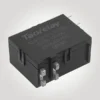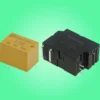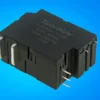What Is a Self Holding Relay?
A self holding relay—also known as a latching relay or bistable relay—is a type of relay that maintains its output state even after the control signal is removed. Unlike traditional electromagnetic relays that require continuous coil power to remain active, a self holding relay uses a magnetic or mechanical mechanism to “lock” its position. This allows the relay to remain energized or de-energized without consuming power continuously.
This characteristic makes self holding relays especially suitable for applications that require low energy consumption, state memory, or power loss protection.

Key Advantages of Self Holding Relays
- Energy Saving
Since the coil only needs a pulse to change states, it consumes minimal power—ideal for battery-powered or energy-conscious systems. - State Retention
The relay remains in its last state even during a power failure, ensuring system continuity and safety. - Long Mechanical Life
Reduced coil operation means less wear and tear, which extends the mechanical lifespan of the relay. - Improved System Reliability
By eliminating the need for continuous power, systems using self holding relays become more stable and cost-effective.
Common Applications of Self Holding Relays
- Smart Power Meters
Used to connect or disconnect load remotely without consuming continuous power. - Industrial Control Systems
Ideal for emergency stop circuits, motor control, or automation panels where state retention is important. - Renewable Energy Equipment
In solar inverters and battery storage systems, self holding relays provide power-off memory and help isolate circuits during faults. - Consumer Appliances
Appliances like smart plugs, lighting control systems, and programmable switches often integrate self holding relays to save energy.
How to Select the Right Self Holding Relay
When choosing a self holding relay, consider the following:
- Rated voltage and current
- Contact configuration (1NO, 1NC, SPDT, etc.)
- Holding mechanism (magnetic vs mechanical)
- Coil control method (single-coil or dual-coil pulse control)
- Mounting type (PCB mount, plug-in, DIN rail)
Always opt for products from reliable manufacturers that offer certified self holding relays (CE, UL, RoHS compliant) to ensure quality and safety.
Conclusion
The self holding relay is a powerful yet efficient component widely used in modern control systems. With its ability to reduce power usage, retain state during power loss, and enhance overall system reliability, it is becoming a staple in applications ranging from energy infrastructure to smart electronics. If you’re developing a control solution and need dependable switching with low standby power, a self holding relay is the smart choice.




